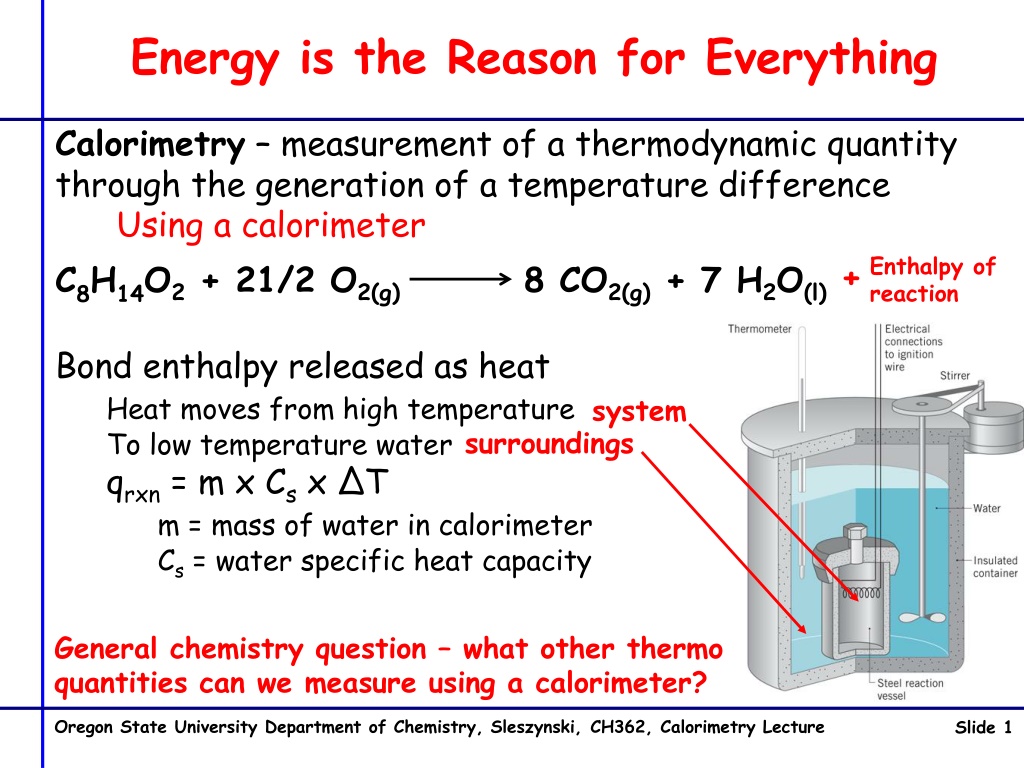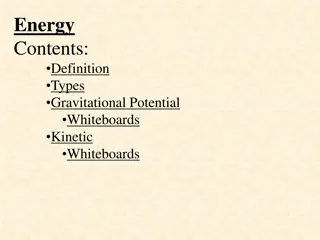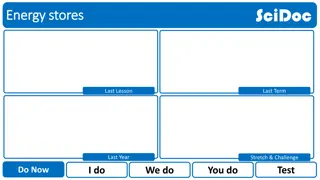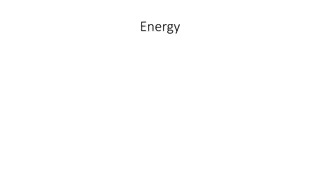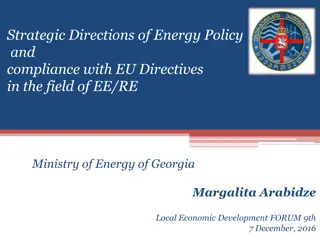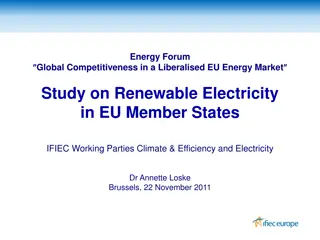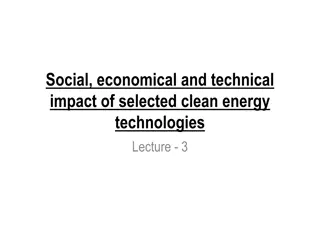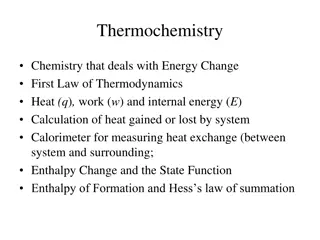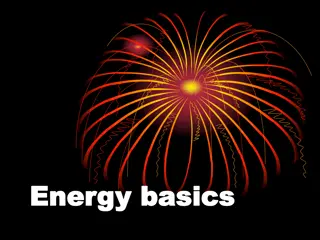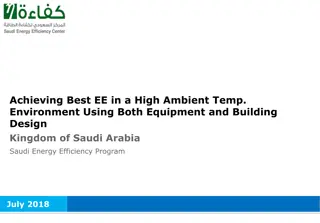Energy is the Reason for Everything
The content delves into the principles of calorimetry and the importance of acknowledging assumptions in thermodynamic measurements. It discusses the calorimetry process, the impact of assumptions on results, and strategies for error correction. Additionally, it explains concepts of accuracy, precision, random error, and systematic error in measurement techniques.
Download Presentation

Please find below an Image/Link to download the presentation.
The content on the website is provided AS IS for your information and personal use only. It may not be sold, licensed, or shared on other websites without obtaining consent from the author.If you encounter any issues during the download, it is possible that the publisher has removed the file from their server.
You are allowed to download the files provided on this website for personal or commercial use, subject to the condition that they are used lawfully. All files are the property of their respective owners.
The content on the website is provided AS IS for your information and personal use only. It may not be sold, licensed, or shared on other websites without obtaining consent from the author.
E N D
Presentation Transcript
Energy is the Reason for Everything Calorimetry measurement of a thermodynamic quantity through the generation of a temperature difference Using a calorimeter Enthalpy of reaction + C8H14O2 + 21/2 O2(g) 8 CO2(g) + 7 H2O(l) Bond enthalpy released as heat Heat moves from high temperature To low temperature water qrxn = m x Csx T m = mass of water in calorimeter Cs = water specific heat capacity system surroundings General chemistry question what other thermo quantities can we measure using a calorimeter? Oregon State University Department of Chemistry, Sleszynski, CH362, Calorimetry Lecture Slide 1
We Always Make Assumptions When We Describe Experiments and Results qrxn = mH2O x Cs H2Ox T What assumptions have we made? Assume makes an ass of u and me True? All of the qrxn has gone into the H2O. What besides the H2O absorbed heat and changed temperature? The energy measured is from the reaction we want to study. What else is generating energy? There is no energy exchange between the calorimeter and the lab environment. Our measurement equipment is error free. True? True? True? ALWAYS ACKNOWLEDGE YOUR ASSUMPTIONS!! They limit the validity of your results How big are the errors from these assumptions? Do the errors invalid your results? Can we correct the errors in these assumptions? Oregon State University Department of Chemistry, Sleszynski, CH362, Calorimetry Lecture Slide 2
Can We Correct the Errors Produced by Our Assumptions? What besides the water is absorbing heat and changing temperature? ? OR Calibrate the entire apparatus using a known compound Methyl salicylate You can measure each individual contributor and sum them up. ASSUMEthat you ve accounted for them all. Fewer assumptions about the apparatus Data always trumps assumptions What errors are we introducing during calibration? Oregon State University Department of Chemistry, Sleszynski, CH362, Calorimetry Lecture
Accuracy and Precision Random Error and Systematic Error What s the difference between precision and accuracy? Precision repeatedly do the same thing? Accuracy how close are you to the correct value Requires that you know the right answer! Not the right thing Run controls Random error Systematic error Not Accurate not Precise Accurate Not Precise Precise Not Accurate Precise & Accurate Instrument calibration and random error: If you only run 1 calibration experiment, and use the data Will that result in a random or systematic error in the rest of your data? Does it matter? Comparing 2 numbers referred to an arbitrary point? Bias Oregon State University Department of Chemistry, Sleszynski, CH362, Calorimetry Lecture
What Do We Want To Measure? What Are We Measuring? Enthalpy of reaction + C8H14O2 + 21/2 O2(g) 8 CO2(g) + 7 H2O(l) Anything in the bomb that reacts with oxygen! What else is in your sample? Starting materials chlorobutyronitrile / cyclohexyl chloride? Butanol / methanol? What s your GC look like? IR? Carboxylic acid? What s your IR look like? Unwanted side products? Contaminants? Silicon grease? Dirty glassware? Fe wire oxidizing! How much? Can we compensate for the impurities? In analytical chemistry, there s no such thing as zero . What else? Water? Oregon State University Department of Chemistry, Sleszynski, CH362, Calorimetry Lecture
What Are We Measuring with Reaction Enthalpy? Our 2 reaction products have the same empirical formula C8H14O6 And the same number of each type of bonds C-H C=O C-C C-O Ifthey re both react to produce the same products 8 CO2 + 7 H2O Then any reaction enthalpy difference must be due to the starting the P-ester/H-ester bond enthalpy differences High energy = unstable = reactive = higher energy released Oregon State University Department of Chemistry, Sleszynski, CH362, Calorimetry Lecture
What is the Source of the Energy Difference? Our assumption is that the only energy difference is structural, from ring strain. P-ester Energy H0 H-ester H0 Products CO2 & H2O Reaction Progress Ring Strain vs Ring Size 30 Ring Strain Energy kcal/mol 25 For sp3 carbons, why are rings other than n = 6 strained higher energy, less stable, more reactive? 20 15 10 5 0 3 4 5 6 Ring Size 7 8 9 10 Oregon State University Department of Chemistry, Sleszynski, CH362, Calorimetry Lecture
Corrections For Experimental Errors Here s an example of what we think your data will look like: Why are these lines sloped? TAKE A LOT OF POINTS!!! Oregon State University Department of Chemistry, Sleszynski, CH362, Calorimetry Lecture Slide 8
Experimental Error in Science To truly understand experimental error we need to run replicates More is better Occasionally we only have n = 1 A super Nova A very expensive experiment An undergrad lab where we don t have unlimited time or equipment (xi-x)2 n SD = Propagation of error It s how we estimate error (~when n = 1) Every time we add a procedural step or a mathematic operation we increase - often multiple - the experimental error Propagation of error is a formalism that reflects the formal error in procedural steps, reflected in any mathematical operation Oregon State University Department of Chemistry, Sleszynski, CH362, Calorimetry Lecture Slide 9
Propagation of Error in Mathematical Operations SD RSD Oregon State University Department of Chemistry, Sleszynski, CH362, Calorimetry Lecture Slide 10
A Warning About Volume Transfer Volumetric flask are TC To Contain It will not accurately deliver a volume Our experimental write up says that differences will average out. What is the criteria for averaging ? What experimental steps violate that criteria? The best of bad experimental options: Speed, accuracy, precision, temperature loss Oregon State University Department of Chemistry, Sleszynski, CH362, Calorimetry Lecture Slide 11
